Bytescout provides seamless and easy to use SDK for reading barcodes from PDF or image file format. In this article, we’ll explore Bytescout Barcode Reader SDK and see various programs to read barcode values from image/PDF files.
Some of the strong points for Bytescout Barcode Reader SDK are as follows:
In order to have better exposure for Bytescout Barcode Reader SDK, we’ll be reviewing the following programs in this article.
These programs will be in C# Console applications. It can be created from the menu File -> New -> Project, then choose “Console Application” under the “Windows” tab. If you are using the latest IDE, at the time of writing this article is Visual Studio 2019, then select “Console App” from the start page.
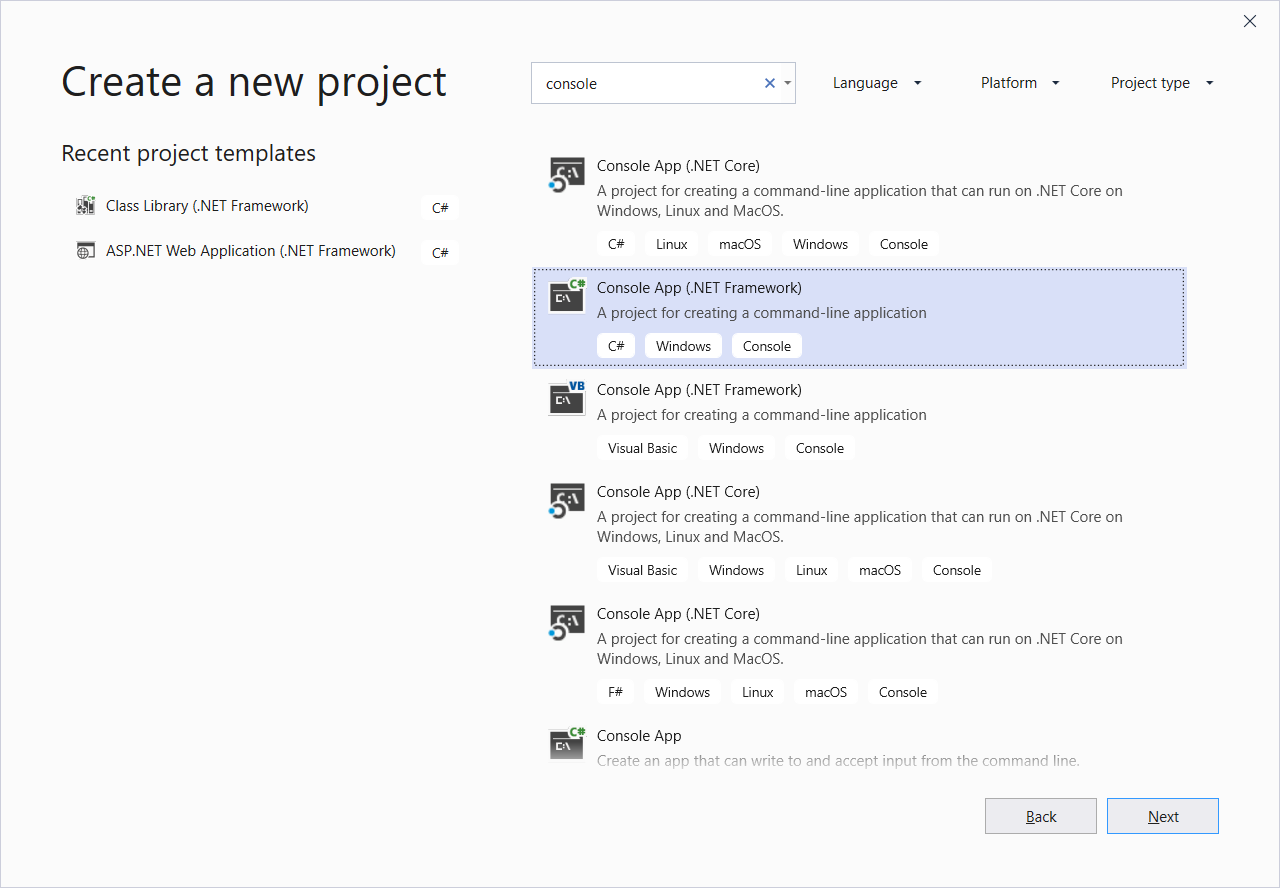
Then we’ll be adding a reference from ByteScout Barcode Reader assembly as shown in the following image.
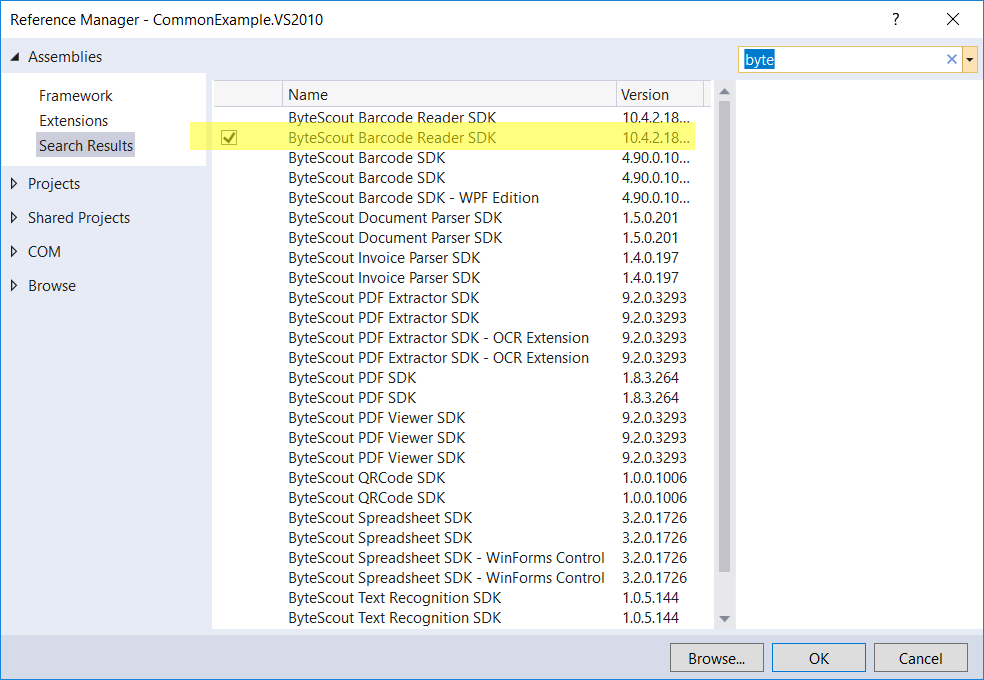
You’ll need to have ByteScout SDK installed in your machine for this assembly reference in the project. This SDK can be downloaded and installed from here.
Let’s get started with the examples.
In this program, we’ll be reading barcodes from the image file. Let’s see the program first and then we’ll analyze it later.
The input file for the program is as follows.
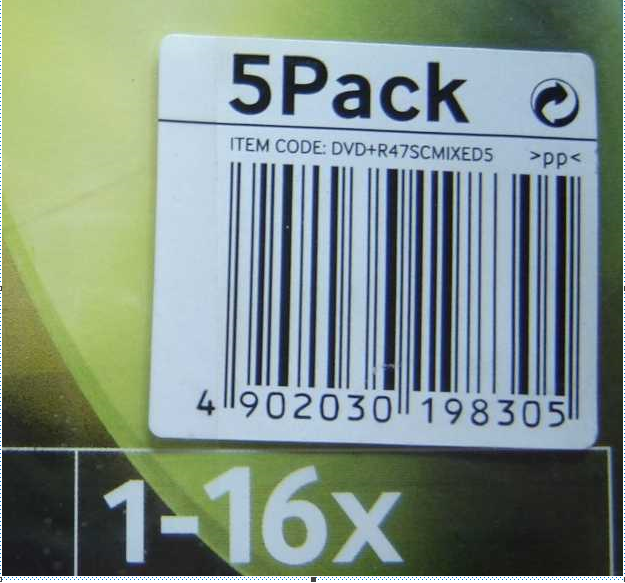
The program is as below.
using System;
using System.IO;
using Bytescout.BarCodeReader;
namespace CommonExample
{
class Program
{
const string ImageFile = "Barcode.jpg";
static void Main()
{
Console.WriteLine("Reading barcode(s) from image {0}", Path.GetFullPath(ImageFile));
Reader reader = new Reader();
reader.RegistrationName = "demo";
reader.RegistrationKey = "demo";
// Set barcode type to find
reader.BarcodeTypesToFind.All = true;
// We recommend using specific barcode types to avoid false positives, e.g.:
// reader.BarcodeTypesToFind.QRCode = true;
// reader.BarcodeTypesToFind.Code39 = true;
// Read barcodes
FoundBarcode[] barcodes = reader.ReadFrom(ImageFile);
foreach (FoundBarcode barcode in barcodes)
{
Console.WriteLine("Found barcode with type '{0}' and value '{1}'", barcode.Type, barcode.Value);
}
// Cleanup
reader.Dispose();
Console.WriteLine("Press any key to exit..");
Console.ReadKey();
}
}
}
And here’s the output.
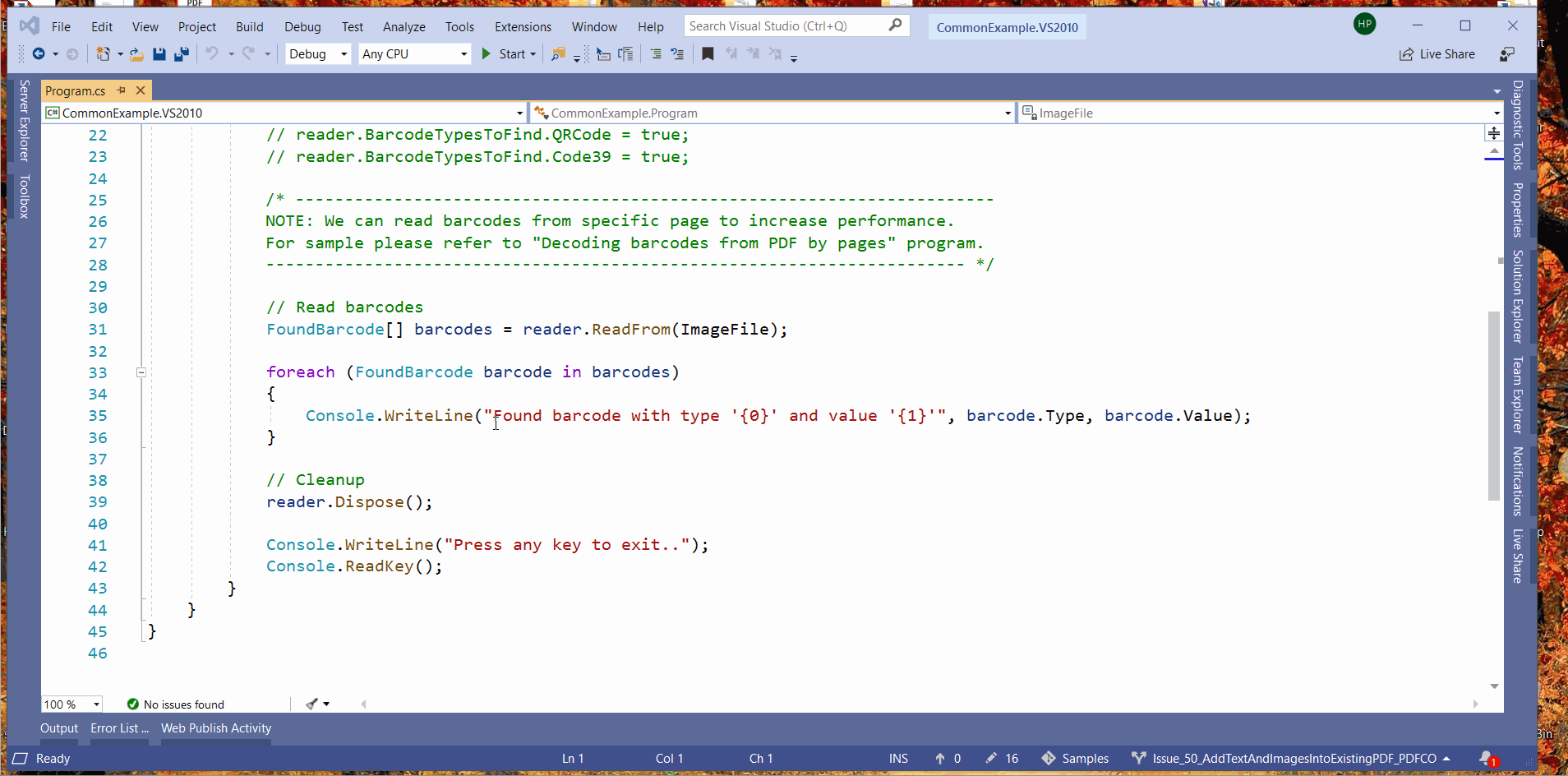
Though the program is self-explanatory, let’s analyze it. This program can be divided into three parts.
Reader reader = new Reader(); reader.RegistrationName = "demo"; reader.RegistrationKey = "demo";
We’re using Reader class from “Bytescout.BarCodeReader” namespace’s instance and assigning registration key and name to it. In this case, we’re using demo keys (which has the limitation of adding watermark text to output). In production usage, one should use actual keys from purchased SDK.
// Set barcode type to find reader.BarcodeTypesToFind.All = true; // We recommend using specific barcode types to avoid false positives, e.g.: // reader.BarcodeTypesToFind.QRCode = true; // reader.BarcodeTypesToFind.Code39 = true;
Here we have enabled finding all types of barcodes from the image by setting “BarcodeTypesToFind.All” property to True. If we are sure about barcode type within input file then we should use specific barcode type(s) to read to increase performance.
FoundBarcode[] barcodes = reader.ReadFrom(ImageFile);
foreach (FoundBarcode barcode in barcodes)
{
Console.WriteLine("Found barcode with type '{0}' and value '{1}'", barcode.Type, barcode.Value);
}
We’re using the ReadFrom method to read all barcodes from the input file. Output values are in the format of FoundBarcode class array; which contains all properties related to barcode such as barcode type, value, barcode position coordinates, etc.
In this example, we’ll see how to read barcode values on a page to page basis from PDF input files or TIFF multipage image file.
The input file is as follows.
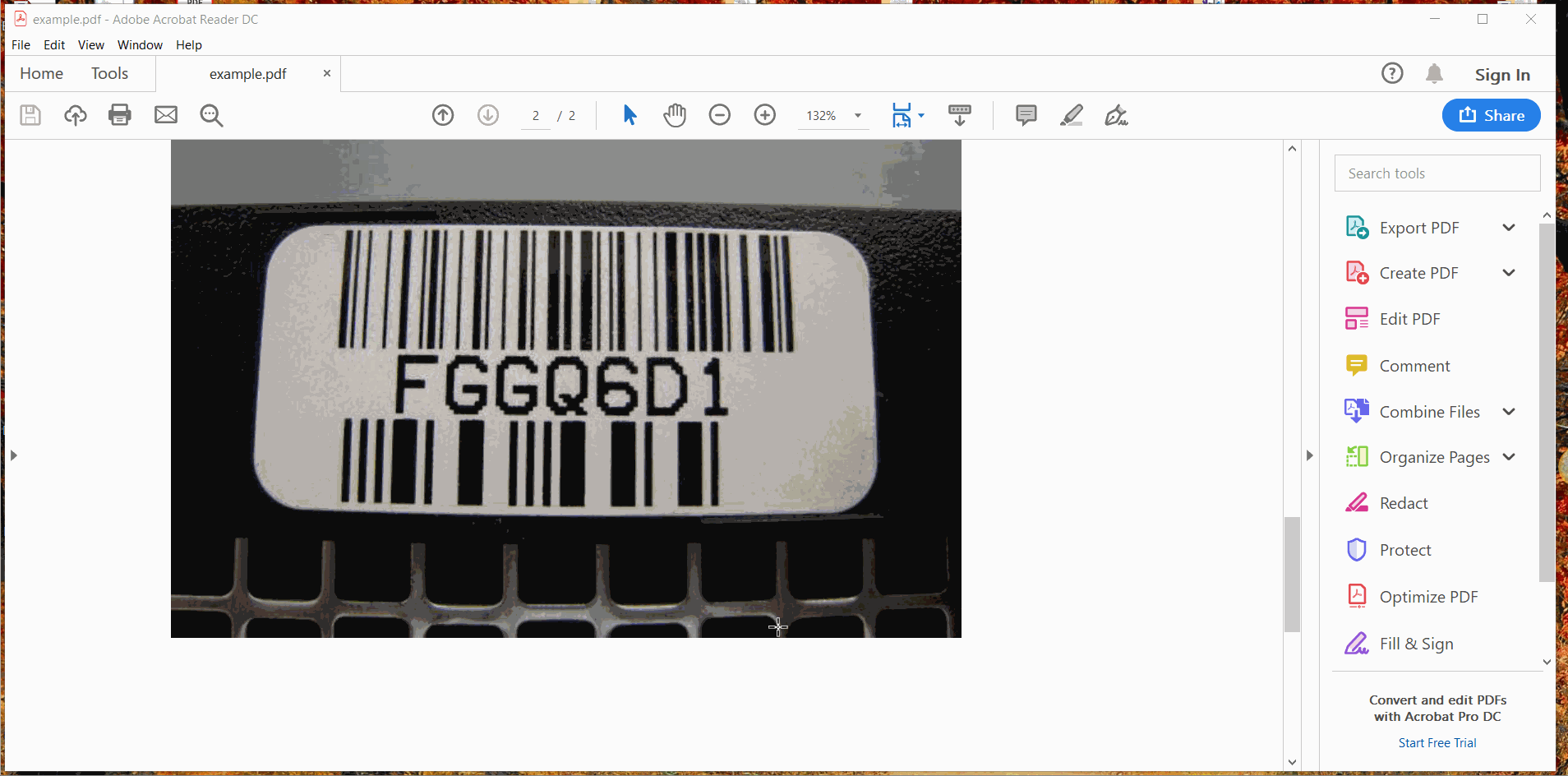
The code is as below.
static void Main()
{
Reader reader = new Reader();
reader.RegistrationName = "demo";
reader.RegistrationKey = "demo";
// Limit search to 1-dimensional barcodes only (exclude 2D barcodes to speed up the processing).
// Change to barcodeReader.BarcodeTypesToFind.SetAll() to scan for all supported 1D and 2D barcode types
// or select specific type, e.g. barcodeReader.BarcodeTypesToFind.PDF417 = True
reader.BarcodeTypesToFind.All1D = true;
// Input filename
string fileName = "example.pdf";
//string fileName = "multipage.tif";
// Pages from which barcodes to be fetched
int[] readFromPages = { 1, 2 };
foreach (var pageNo in readFromPages)
{
Console.WriteLine("\n\nReading barcodes from PDF page {0}...", pageNo);
// Decoding barcodes from PDF on page-by-page basis instead of reading the whole page
FoundBarcode[] barcodes = reader.ReadFrom(fileName, (pageNo - 1));
// Found results
foreach (FoundBarcode barcode in barcodes)
{
Console.WriteLine("Found Barcode, Type: '{0}', Value: '{1}', Position: {2}",
barcode.Type, barcode.Value, barcode.Rect);
}
}
// Cleanup
reader.Dispose();
Console.WriteLine();
Console.WriteLine("Press any key to continue.");
Console.ReadKey();
}
The output is as follows.
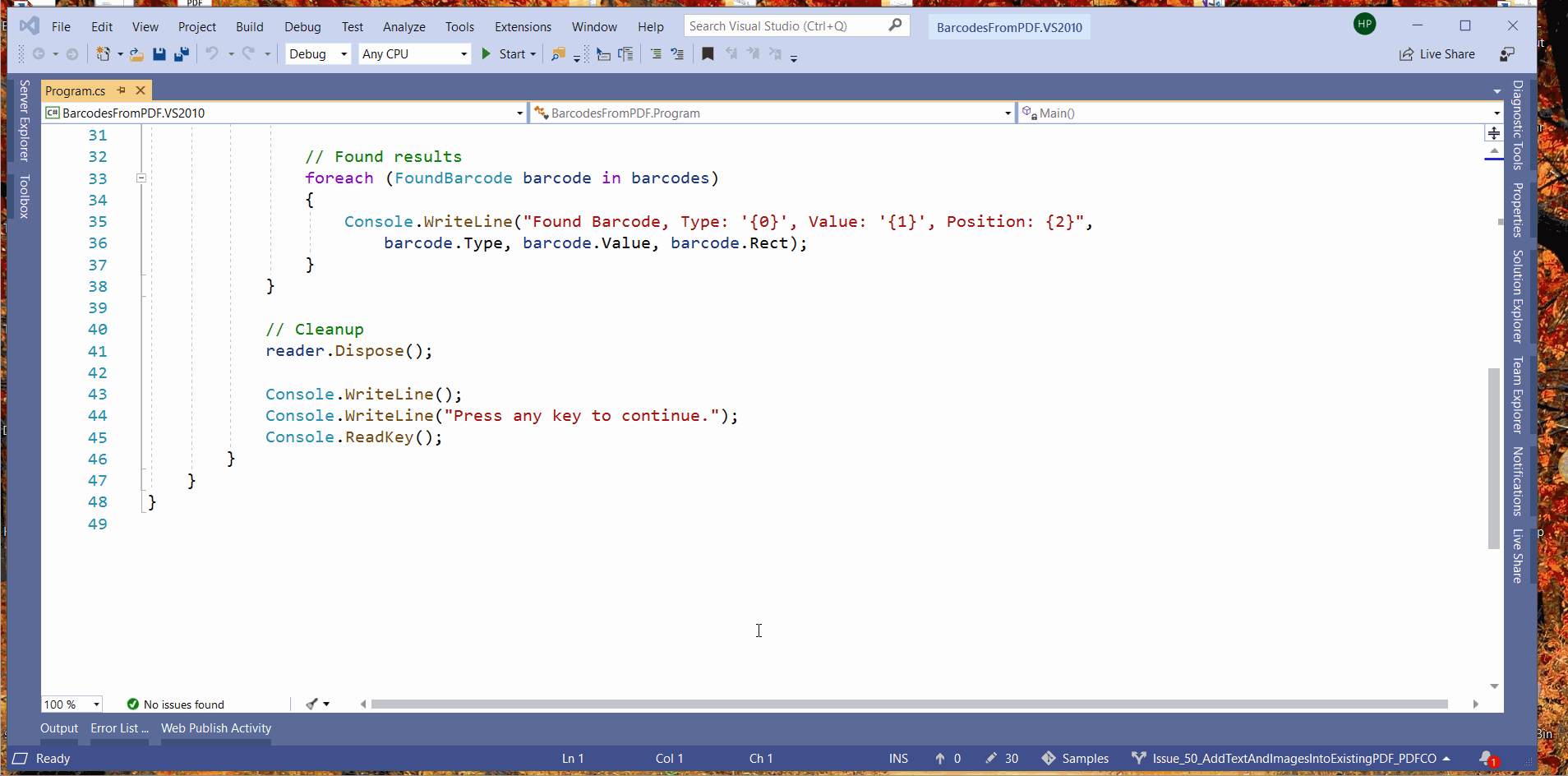
This example is mostly similar to the previous one, let’s analyze the differences.
We have given a multipage PDF file as input as shown below. Here we can instead give tiff file as input too.
// Input filename string fileName = "example.pdf"; //string fileName = "multipage.tif";
Then we’ve specified pages to read barcodes from. Page numbers in the method are zero indexes based, so when we are inside ReadFrom method we are deducting one from it.
// Pages from which barcodes to be fetched
int[] readFromPages = { 1, 2 };
The last step is to iterate from each page, and looking for barcodes in that page. We’re using an overloaded version of method ReadFrom which accepts the second parameter for page no.
// Decoding barcodes from PDF on page-by-page basis instead of reading the whole page
FoundBarcode[] barcodes = reader.ReadFrom(fileName, (pageNo - 1));
Then it’s displaying found barcode information such as barcode type, value, it’s position coordinates in the console.
Console.WriteLine("Found Barcode, Type: '{0}', Value: '{1}', Position: {2}",
barcode.Type, barcode.Value, barcode.Rect);
In this example, we’ll see how to read checkboxes with Bytescout Barcode Reader library.
The input file is as follows.
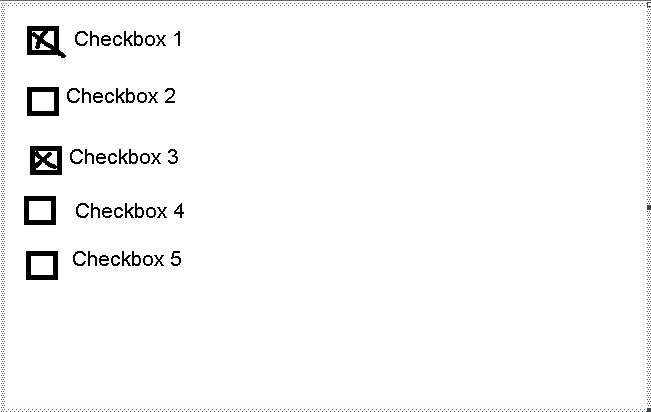
The program code is as below.
class Program
{
const string ImageFile = "checkboxes-checked.png";
static void Main()
{
Console.WriteLine("Reading checkboxes from image {0}", Path.GetFullPath(ImageFile));
Reader reader = new Reader();
reader.RegistrationName = "demo";
reader.RegistrationKey = "demo";
// Enable check boxes recognition
reader.BarcodeTypesToFind.Checkbox = true;
// Find check boxes
FoundBarcode[] barcodes = reader.ReadFrom(ImageFile);
foreach (FoundBarcode barcode in barcodes)
{
Console.WriteLine("Found checkbox with type '{0}' and value '{1}'", barcode.Type, barcode.Value);
}
// Cleanup
reader.Dispose();
Console.WriteLine("Press any key to exit..");
Console.ReadKey();
}
}
The output is as follows.
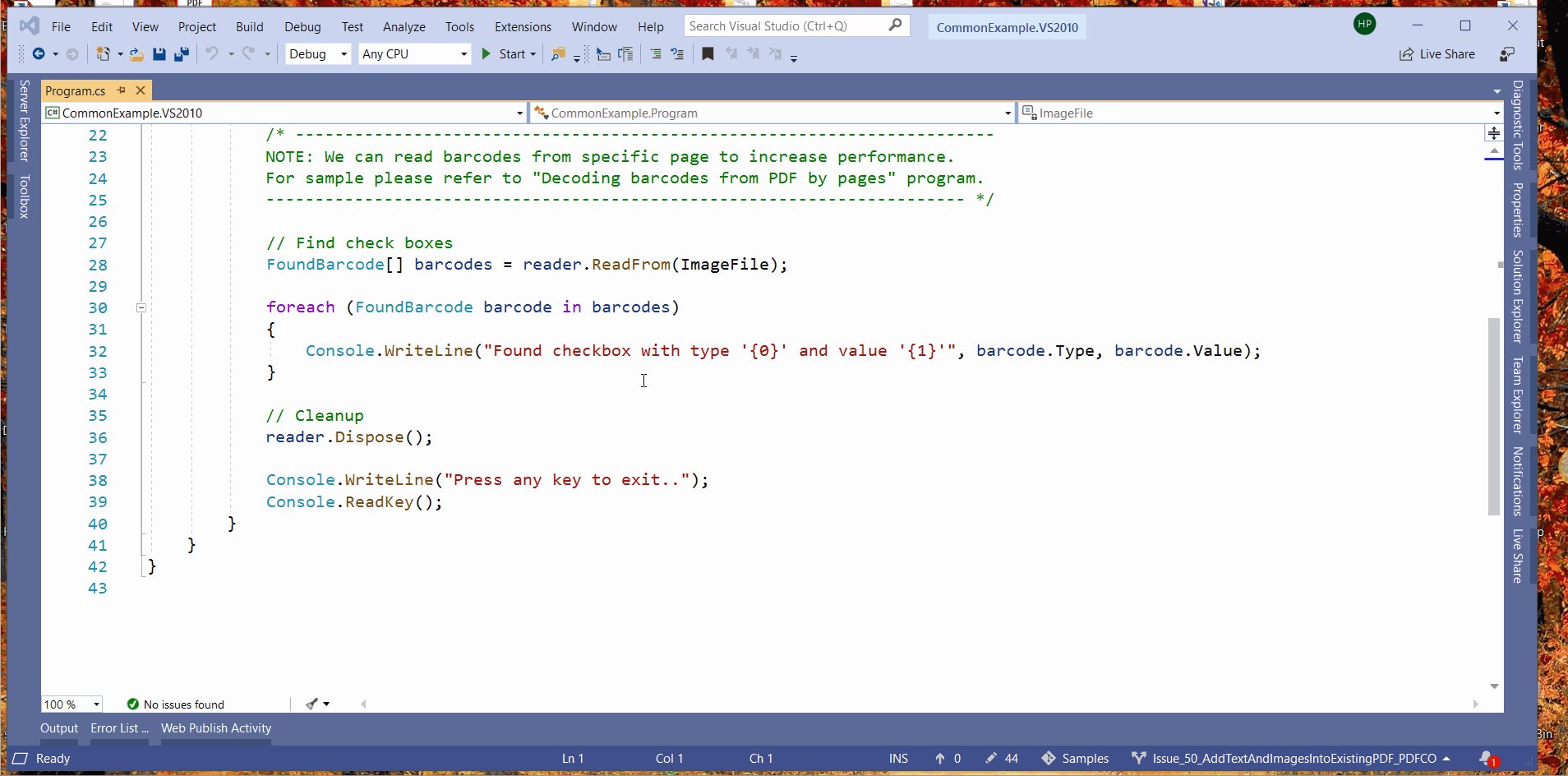
Here Barcode type to find for the checkbox is set to true, which enables the finding of all checkbox type from the input document.
// Enable check boxes recognition
reader.BarcodeTypesToFind.Checkbox = true;
If we see the output; as this is the checkboxes it’s output is in the format of 1 and 0s. If Checkbox is checked it’ll be 1 else it’ll be 0.
In this example, we’ll see how to export found barcodes in files of different formats such as XML, CSV, TXT, JSON, etc.
The input file to the program is as follows.
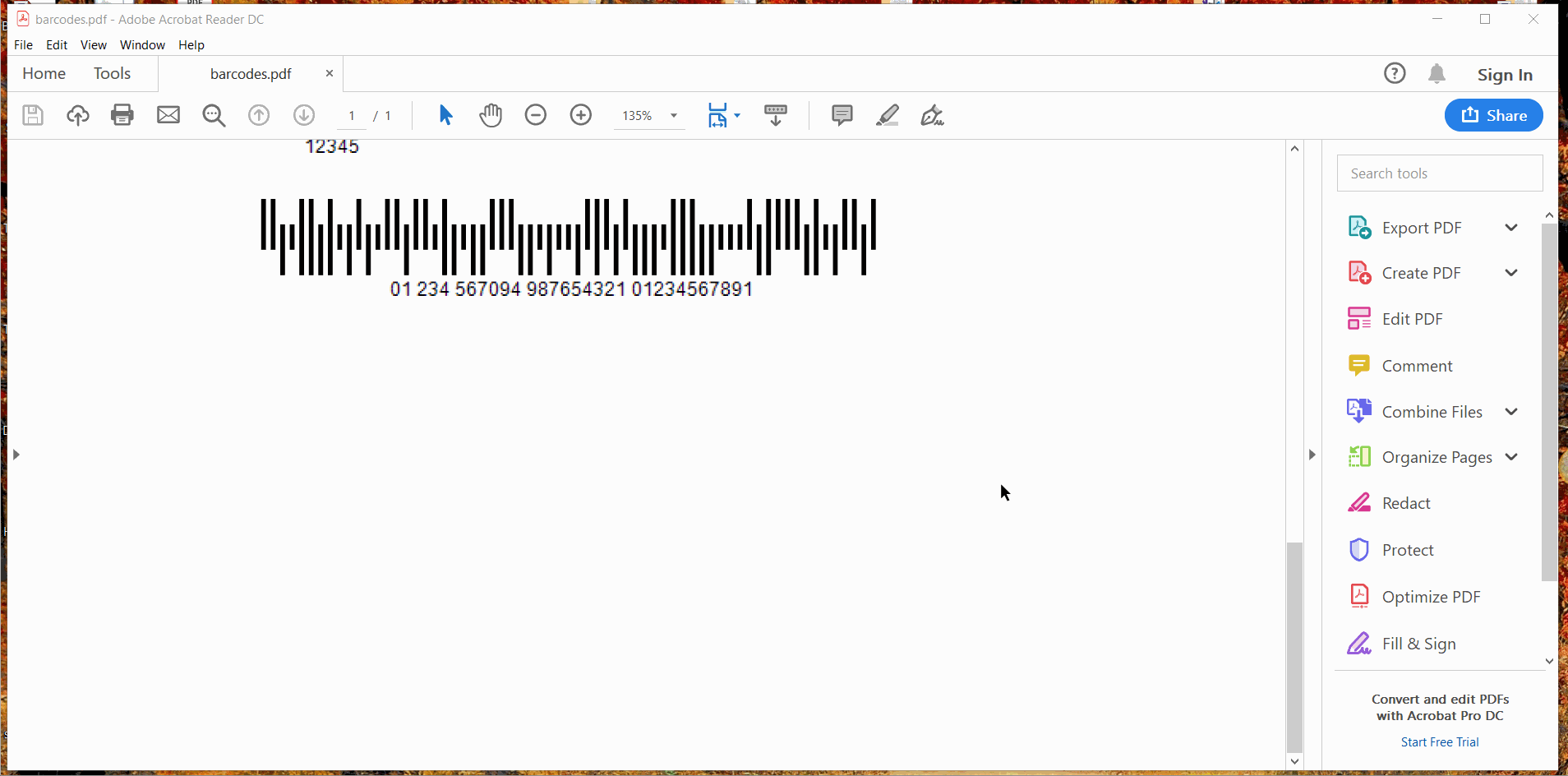
The program is as below.
class Program
{
static void Main()
{
Reader reader = new Reader();
reader.RegistrationName = "demo";
reader.RegistrationKey = "demo";
// Set barcode type to find
reader.BarcodeTypesToFind.All1D = true;
// Read barcodes
reader.ReadFromFile("barcodes.pdf");
// Export to files:
// ================
// 1. Export found barcodes to XML
reader.ExportFoundBarcodesToXML("barcodes.xml");
// 2a. Export found barcodes to CSV with default delimiter, quotation and character encoding
reader.ExportFoundBarcodesToCSV("barcodes.csv");
// 2b. Export found barcodes to CSV with custom delimiter, quotation and character encoding
reader.ExportFoundBarcodesToCSV("barcodes2.csv", "|", "'", Encoding.UTF8);
// 3a. Export found barcodes to plain text file in default character encoding
reader.ExportFoundBarcodesToTXT("barcodes.txt");
// 3b. Export only values of found barcodes to plain text file in custom character encoding
reader.ExportFoundBarcodesToTXT("barcodes2.txt", true, Encoding.ASCII);
// Get formatted result to a variable for further processing
// =========================================================
// 5a. Get found barcodes as XmlDocument
XmlDocument xmlDocument = reader.ExportFoundBarcodesToXMLDocument();
// 5b. Get found barcodes as XML string
string xmlString = reader.ExportFoundBarcodesToXML();
// 6a. Get found barcodes as string in CSV format with default delimiter and quotation
string csv = reader.ExportFoundBarcodesToCSV();
// 6b. Get found barcodes as string in CSV format with custom delimiter and quotation
string csv2 = reader.ExportFoundBarcodesToCSV("|", "'");
// 7. Get found barcodes as string in plain text format
string txt = reader.ExportFoundBarcodesToTXT();
// 8. Get found barcodes as string in JSON format
string jsonString = reader.ExportFoundBarcodesToJSON();
// Cleanup
reader.Dispose();
}
}
And the output is as follows.
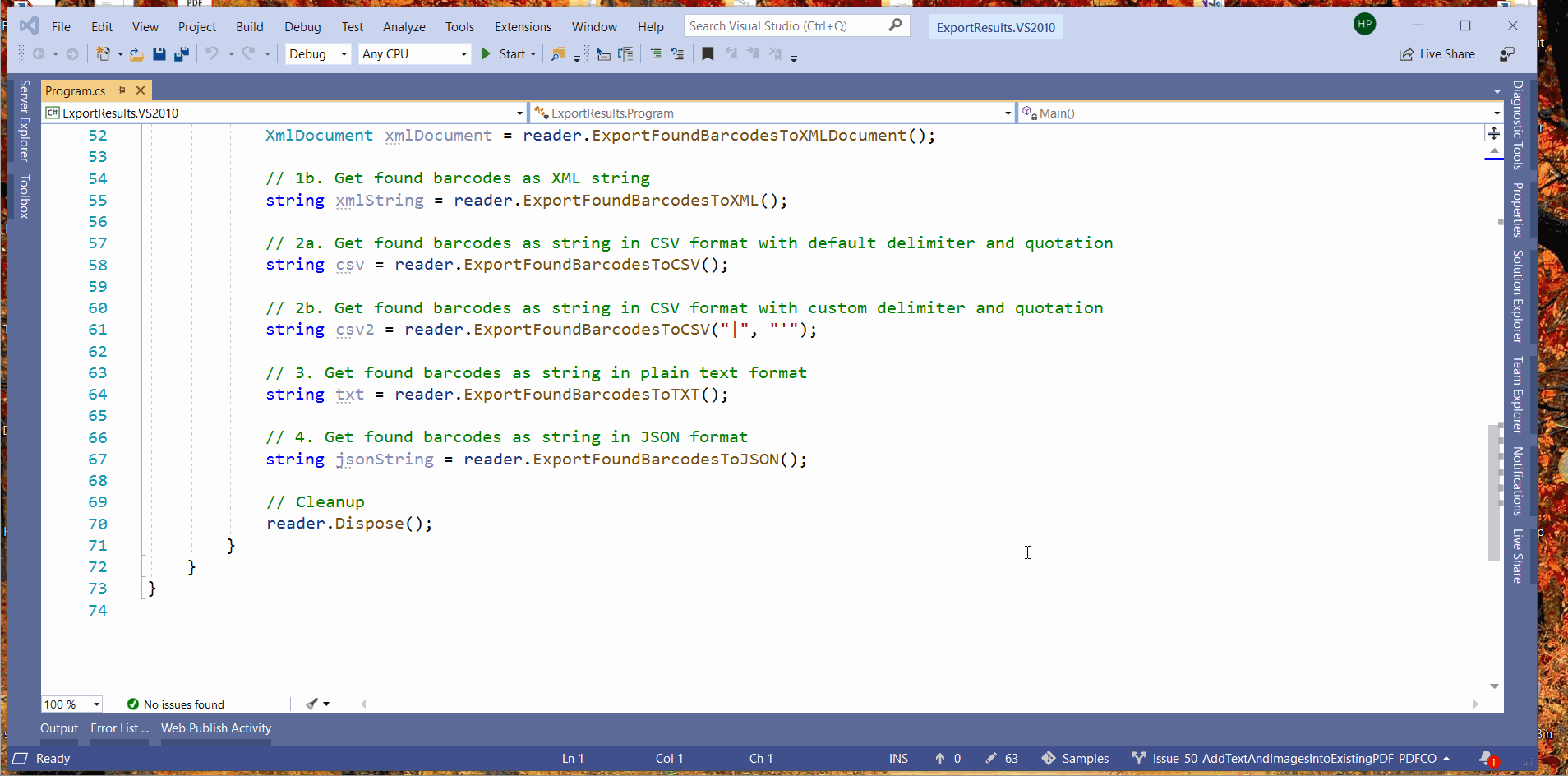
Let’s analyze this code. In this example, we’re reading all one-dimensional barcodes from PDF file.
// 1. Export found barcodes to XML
reader.ExportFoundBarcodesToXML("barcodes.xml");
// 5a. Get found barcodes as XmlDocument
XmlDocument xmlDocument = reader.ExportFoundBarcodesToXMLDocument();
// 5b. Get found barcodes as XML string
string xmlString = reader.ExportFoundBarcodesToXML();
// 2a. Export found barcodes to CSV with default delimiter, quotation and character encoding
reader.ExportFoundBarcodesToCSV("barcodes.csv");
// 2b. Export found barcodes to CSV with custom delimiter, quotation and character encoding
reader.ExportFoundBarcodesToCSV("barcodes2.csv", "|", "'", Encoding.UTF8);
// 6a. Get found barcodes as string in CSV format with default delimiter and quotation
string csv = reader.ExportFoundBarcodesToCSV();
// 6b. Get found barcodes as string in CSV format with custom delimiter and quotation
string csv2 = reader.ExportFoundBarcodesToCSV("|", "'");
// 3a. Export found barcodes to a plain text file in default character encoding
reader.ExportFoundBarcodesToTXT("barcodes.txt");
// 3b. Export only values of found barcodes to plain text file in custom character encoding
reader.ExportFoundBarcodesToTXT("barcodes2.txt", true, Encoding.ASCII);
// 7. Get found barcodes as string in plain text format
string txt = reader.ExportFoundBarcodesToTXT();
// 8. Get found barcodes as string in JSON format
string jsonString = reader.ExportFoundBarcodesToJSON();
In applications where barcode reading is implemented, speed is a very essential element; an end-user might be surrounded by a long queue!
In this example, we’ll see how to reduce CPU usage and make speedy barcode read operation.
Input document for this program is as follows.
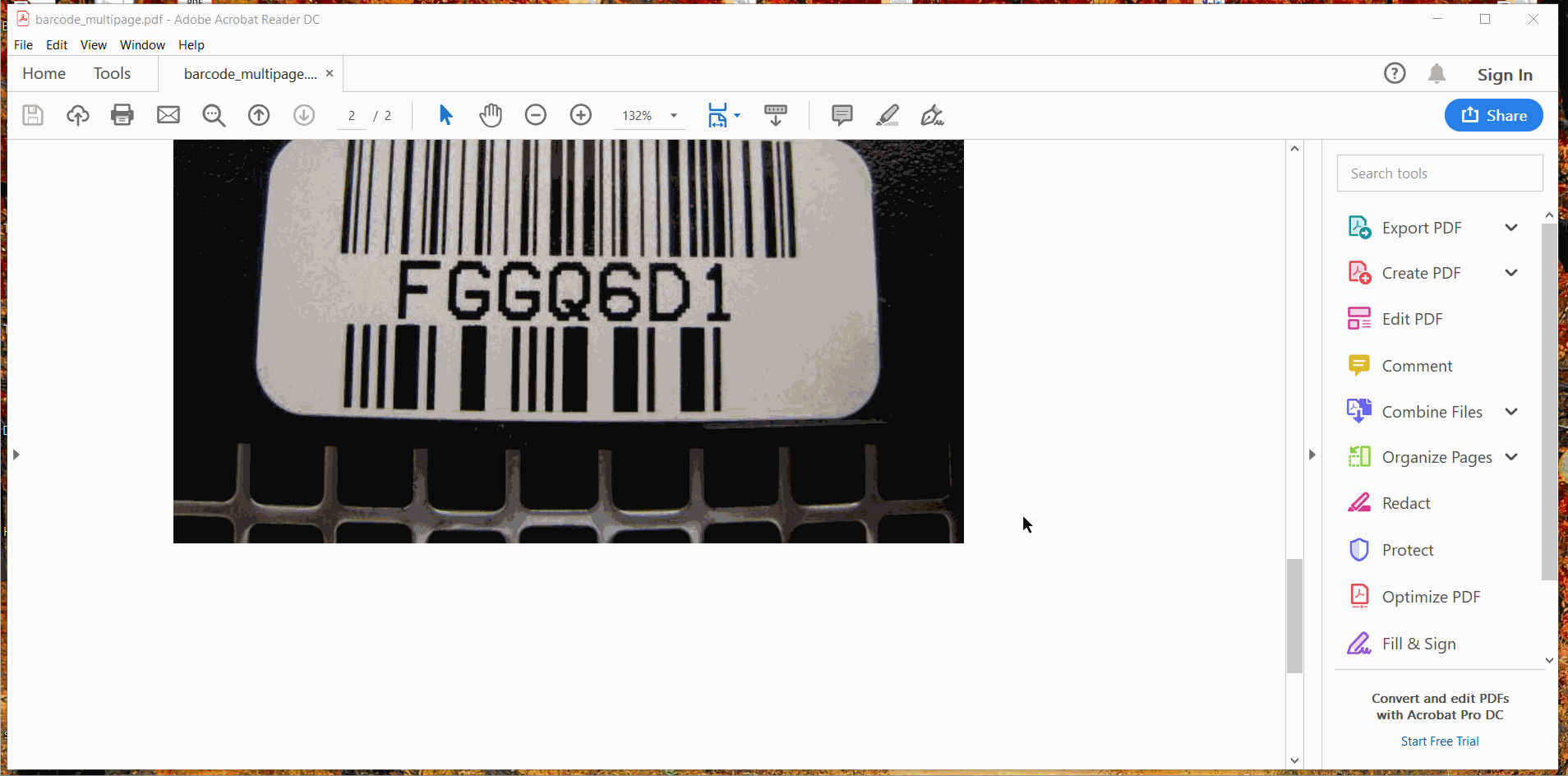
The program is as below:
class Program
{
static void Main()
{
// Barcode reader instance
Reader reader = new Reader();
reader.RegistrationName = "demo";
reader.RegistrationKey = "demo";
// Input filename
string inputFileName = "barcode_multipage.pdf";
// Set specific barcode type to read
reader.BarcodeTypesToFind.Code128 = true;
// Reduce PDF rendering resolution
reader.PDFRenderingResolution = 150;
// Set specific area to read from
reader.CustomAreaLeft = 407;
reader.CustomAreaTop = 494;
reader.CustomAreaHeight = 605;
reader.CustomAreaWidth = 999;
// Set specific page to read from along with filename
reader.ReadFromPdfFilePage(inputFileName, 1, 1);
// Get all found barcodes
FoundBarcode[] barcodes = reader.FoundBarcodes;
// Display found barcodes
Console.WriteLine("Reading barcode(s) from PDF file...");
foreach (FoundBarcode barcode in barcodes)
{
Console.WriteLine("Found Barcode - Type: '{0}', Value: '{1}'", barcode.Type, barcode.Value);
}
// Cleanup
reader.Dispose();
Console.WriteLine();
Console.WriteLine("Press any key to continue.");
Console.ReadKey();
}
}
The output is as follows:
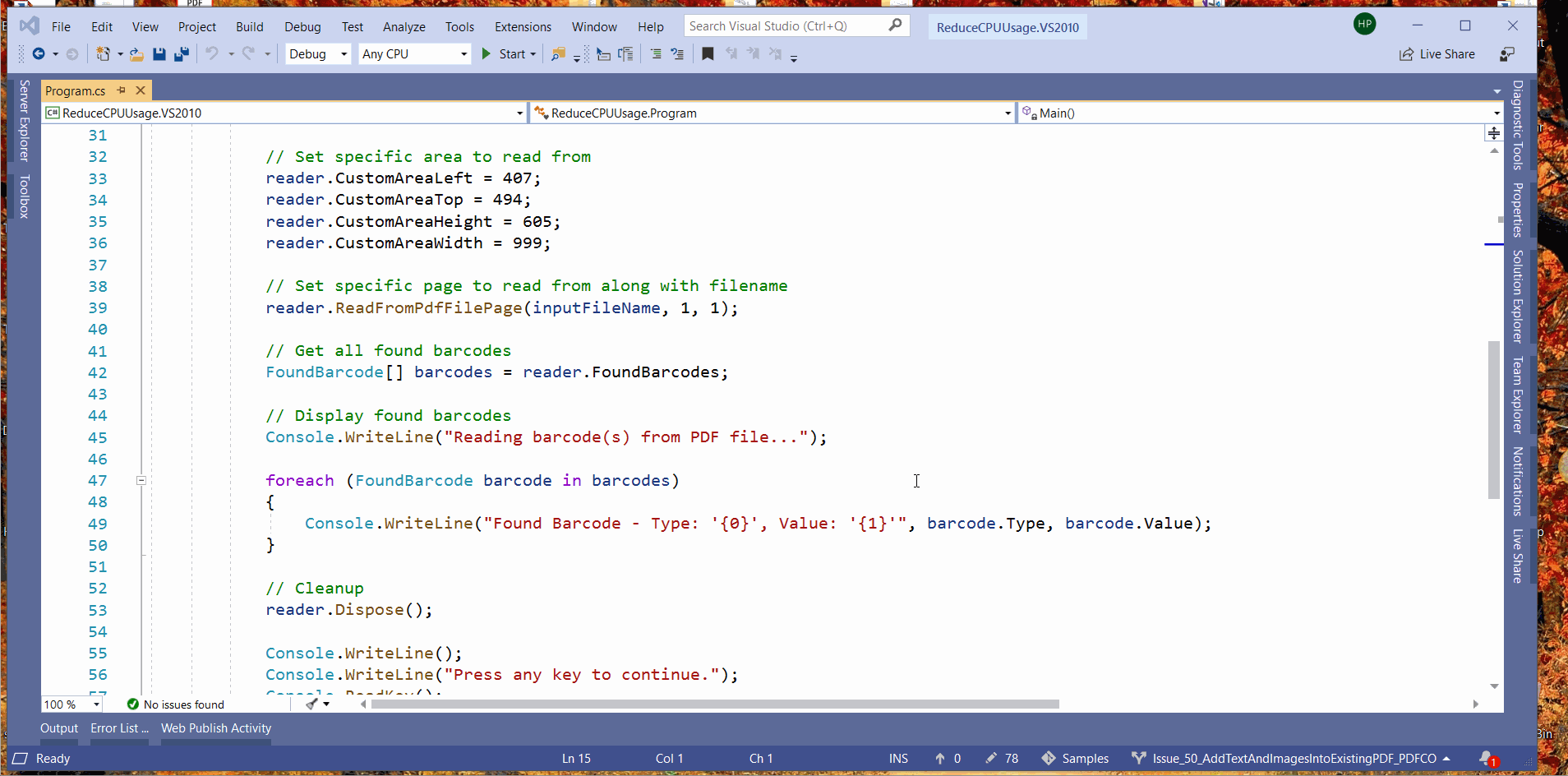
In order to reduce CPU and RAM load following are the steps, we can consider:
In this program, we are reading barcode from a multipage document, and we are following the same guidelines specified above.
// Set specific barcode type to read
reader.BarcodeTypesToFind.Code128 = true;
// Reduce PDF rendering resolution
reader.PDFRenderingResolution = 150;
// Set specific area to read from
reader.CustomAreaLeft = 407;
reader.CustomAreaTop = 494;
reader.CustomAreaHeight = 605;
reader.CustomAreaWidth = 999;
// Set specific page to read from along with filename
reader.ReadFromPdfFilePage(inputFileName, 1, 1);
That’s all guys. I hope you enjoyed this article and have a bit of insight into Bytescout Barcode Reader SDK. You can refer to this link to explore more.
You can also use a barcode reader online for simple non-programming tasks.
Happy Coding 🙂